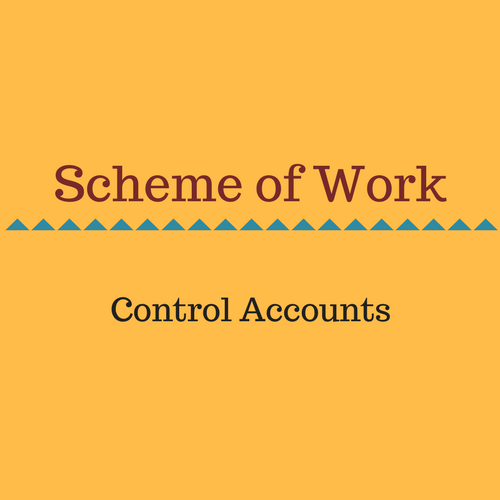|
|
- Home
- Accounting
- Control Accounts
- Control Accounts Resources
Control Accounts Resources for Educators.
Control Accounts Resources includes the "scheme of work" for this topic.
This Scheme of Work outlines the useful resources, activities and assessment strategies to achieve the learning aims and objectives of this topic.
Control Accounts Resources also includes "past paper question listing" for this topic.
Past paper question listing helps the educators and students to understand the style and depth of the assessment. Accounting-Daddy.com suggests the students to refer this part of Control Accounts Resources to score higher marks in the CIE Examinations.
Control Accounts Resources - Scheme of Work
|
Suggested prior knowledge: |
To comprehend this topic and to achieve the learning objectives successfully, students should have the previous knowledge of the following areas: An understanding of double entry book-keeping. Division of the ledger in to Sales, Purchases and General ledgers. The purpose of trial balance. An understanding of books of prime entry. A brief knowledge about various types of errors. |
|
Context: |
When business has grown and the transactions increased in many folds, errors and fraud can occur. It is very difficult to detect these errors and fraud just by depending on trial balance. So control accounts are prepared to act as a check on the individual accounts within the sales and purchases ledgers to deter the fraud and locate the errors quickly. |
|
Teaching time: |
Cambridge recommends four hours of teaching time for this topic. Depending on students’ ability to grasp the topic and learning activities planned, it may be extended to four and half hours. |
|
Syllabus reference: |
Cambridge O Level - Principles of Accounts (7110): 6.2 Accounting procedures - 6.2.4 Control Accounts. Cambridge IGCSE – Accounting (0452): 6.3 Verification of accounting records - 6.3.4 Control Accounts. |
|
Learning objectives: |
Students should be able to: comprehend the uses, advantages and limitations of control accounts. explain that control accounts are an independent check on the sales and purchases ledgers. explain that control accounts may be used to provide totals of trade receivables and trade payables, locate errors and act as a deterrent against fraud. identify and use the books of prime entry as sources of information for control account entries. enter items into the relevant control account. prepare Sales ledger control account and Purchases ledger control account. |
|
Suggested teaching activities: |
Ask the learners to explain the purpose of trial balance. As more answers pouring in from the learners, gradually introduce the topic "control accounts" as an alternative for trial balance to check the arithmetical accuracy of the ledgers. Explain the purpose,uses and limitations of control accounts. Give formats for sales ledger control account and purchases ledger control account. Introduce various items to be posted in the control accounts and source of information for each of these items. Divide the class into two groups and assign a task of preparing a poster displaying the control accounts formats for classroom display. Demonstrate the preparation of sales and purchases ledger control accounts with simple items. Invite the learners in pairs to solve the problems on the board. Prepare flash cards with control account items. Divide the class in two groups. Ask one group to pick a card for the other group. The group which got the card has to state the source of information for each item, in which control account that item would appear and whether it is a debit or credit. Repeat this activity with the second group. Continue this activity until enough number of students got the chance to participate. Prepare a set of completed sales ledger accounts and a separate set of entries in books of prime entry, making sure that there are some differences (e.g. bad debt not entered in trade receivables’s account). Divide class into two groups – one to prepare control account from the actual ledger and the other using the books of prime entry. Brain-storm the reason for the difference in the closing balances. Once learners gained the confidence of preparing the control accounts independently, introduce complex items of control accounts. Prepare worksheets based on past paper questions and ask students to practice given worksheets at home. Control Accounts resources section of this website provides list of past paper questions for this topic. Take students to the ICT Lab in the school and conduct an online surprise test using interactive quizzes on control accounts at www.accounting-daddy.com |
|
Learning resources: |
Offline resources: Business Accounting, Volume 1, 13th Edition by Alan Sangster and Frank Wood, ISBN10: 1292084669 /ISBN13: 9781292084664 Business Accounting: Multiple-Choice Question Book, by Tommy Robinson and Frank Wood, ISBN 027364193X, 9780273641933. Cambridge O Level Principles of Accounts, Authored by Catherine Coucom, ISBN 978-1-107-60478-0 IGCSE and O Level Accounting, Authored by Catherine Coucom, ISBN 978 0521 72001 4. Essential Accounting for Cambridge IGCSE, Authored by David Austen, Christine Gilchrist and Peter Hailstone, ISBN 10:0198357524, ISBN 13:978-0198357520 Essential Accounting for Cambridge IGCSE Workbook, Authored by David Austen, Christine Gilchrist and Peter Hailstone, ISBN:978 1408 52553 1. IGCSE and O Level Accounting Workbook, Authored by Catherine Coucom, ISBN 10: 0521144159/ISBN 13: 9780521144155 Online control account resources: www.accounting-daddy.com |
Disclaimer: This scheme of work has been drafted loosely based on CIE Scheme of Work. For original CIE version. Click here!
Learning Corner ::::: Click here to learn how to write a Scheme of Work effectively!
Control Accounts Resources for students.
Control Accounts Resources - Past paper question listing:
(Updated till May/June-2017)
CIE Past Paper questions from "Control Accounts"
CIE Syllabus reference: Cambridge O Level - Principles of Accounts (7110):
6.2 Accounting procedures - 6.2.4 Control accounts
- May/June 2017 - Paper 7110/22 - Q.No-2 (a,b)
- Oct/Nov 2016 - Paper 7110/21 - Q.No-2 (a,b)
- Oct/Nov 2015 - Paper 7110/22 -Q.No-2 (a)
- May/June 2015 - Paper 7110/21 - Q.No-2 (a,b)
- May/June 2014 – Paper 7110/22 – Q.No-2 (a)
- Oct/Nov 2013 – Paper 7110/22 – Q.No-2 (a-c)
- May/June 2012 – Paper 7110/21 – Q.No-2 (a,b)
- Oct/Nov 2011 – Paper 7110/22 – Q.No-2 (a,b)
- May/June 2011 – Paper 7110/21 – Q.No-2 (a,b)
- May/June 2010 – Paper 7110/22 – Q.No-2 (a)
- May/June 2007 – Paper 7110/2 – Q.No-1 (b)
- May/June 2005 – Paper 7110/2 – Q.No-3
- Oct/Nov 2002 – Paper 7110/2 – Q.No-4 (Reconciliation)
- May/June 2002 – Paper 7110/2 – Q.No-2 and Q.No-3 (a-ii)
- Oct/Nov 2001 – Paper 7110/2 – Q.No-3
- Oct/Nov 1999 – Paper 7110/2 – Q.No-6
- May/June 1999 – Paper 7110/2 – Q.No-5
|
|






New! Comments
Have your say about what you just read! Leave us a comment in the box below.